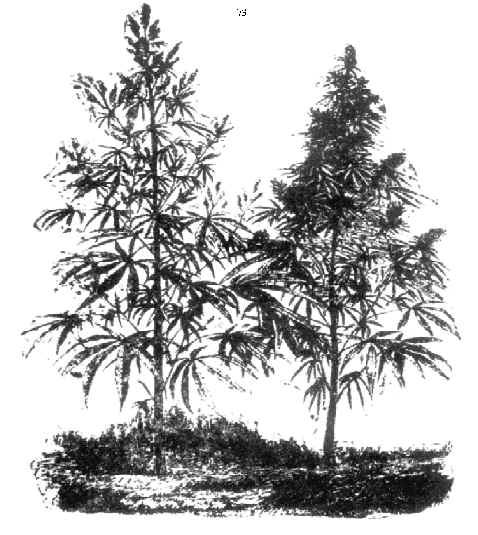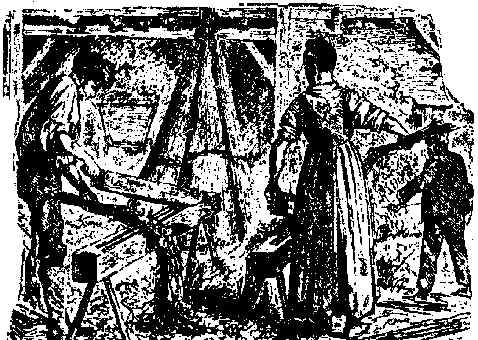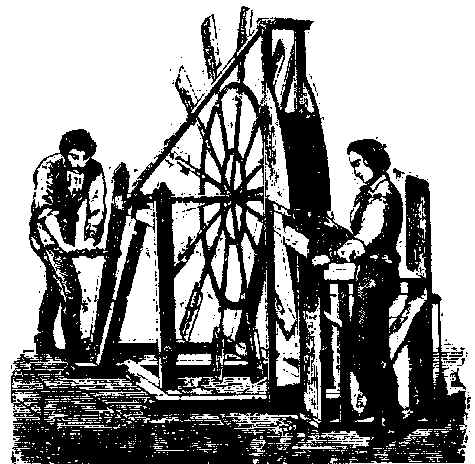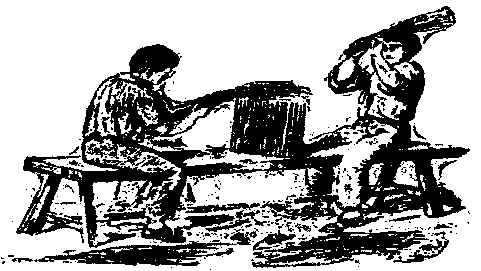
72
History of hemp in Chile
Erich Forster
Safari Seeds, 774 Mays Blvd. #10, Incline, Nevada 89451, USA
Hemp farming began in Central
and South America during the time of the Spanish Conquest (circa 1500 AD). Spain was
a very strong naval power, and depended upon hemp ropes and sails to outfit their vessels
plying the Atlantic Ocean to the resource-rich New World. Hemp was sown in many
places almost immediately upon arrival, in the hope that they could produce their own
hemp, and not depend on foreign merchants for this important strategic resource.
Mexico, Chile, Peru and Colombia all had their initial crops, but only Mexico (California)
and Chile had any long-term favorable results.
The word for hemp in Spanish is 'caņamo', and
although originally a term specific to Cannabis hemp, now generally means plant
fiber. So in fact, there are many types of fibers in Chile that go under the name of
caņamo (hemp), just as there are many types of 'ma' in Chinese, and 'hemp' in English.
In Chile, the list of fibers known as caņamo starts with major fiber plants such
as Cannabis, flax, jute, ramie, Manila hemp and broom sorghum and such minor
fiber species as 'esparto' grass, 'ortiga' (nettles), Agave (century plant) , Raphia
palm, 'totora' (rush), 'cardon' (giant thistle) and blackberry vine. Many of
these minor species have been used since ancient times by indigenous Chilean peoples to
supply their fiber needs.
Hemp was a very important item for the
Conquistadors. Since hemp is an annual plant that grows very rapidly, they could be
assured of a relatively quick and efficient harvest. Hemp also proved ideal for the
mobile lifestyle of the Conquistadors, their early descendants, and the native peoples.
Hemp was so important to the Spanish Crown that in many parts of the Spanish New
World, orders were imposed requiring that farms produce their quota of hemp to be
delivered to the Viceroy. Spain became even more dependent on the colonies as their
economic situation at home plummeted. Hemp experts were dispatched to the new world
to promote the increased production of hemp for export to Europe.
Certain regions of the New World favored the
production of fiber and/or seed better than others. The success of hemp in the
Spanish New World may have been limited because the first seeds grown were of a temperate
European origin and were not adapted to the tropics. Chile and Argentina are in a
geographical position covering latitudes identical with Spain, though in different
hemispheres, and having opposite seasons. Considering the European origin of the
first hemp seed in the New World, and thus its strong preference for European-like
environmental conditions, it is apparent why hemp took a strong hold in Chile and to a
lesser extent in California, both with Mediterranean and temperate climates similar to
Europe. The initial plantings of hemp in Chile took place north of Santiago in the
Valparaiso district near the town of Quillota where it continued to grow continuously for
the next 400 years.
Argentina could have been more successful in
commercial hemp production except that approximately 80% of the water from the Andes
mountains flow to the Chilean side, thus giving Chilean farmers a greater capacity to
irrigate and to conduct the water-requiring processing of the hemp fibers. This
water resource and the ideal climate, are the biggest factors that have kept hemp
cultivation viable in Chile to this day.
Hemp was not only for military and strategic
uses, but was an extremely important item in everyday farm life, being used to make sacks,
shoes, canvas, clothes, rope, cable, twine, bow strings, lassos, saddles, animal feed and
seed oil. To this day, many a Chilean farmer still gets a gleam in his eye when he
sees a good quality hempen sack. One sack is easily worth 5 liters of freshly
pressed and fermented grape "chica"! The agrarian culture puts a high
premium on natural fiber products. They put these products to their ultimate test on
the farm, and they know how well they function. A hemp sack or rope is more valuable
than a plastic substitute because hemp will last much longer. If it was not so
expensive, many Chileans would prefer hemp sacks and ropes.
At one time, hemp farms could be found in
practically all parts of Chile, from the extreme north to the south. Over time, the
hemp industry became concentrated in a few central areas with ideal climatic factors and
nearby processing factories. Hemp farms continued on a grand scale into the early
1980's, after which time production slowed steadily. The main factor seems to be the
replacement of hemp sacks and ropes with more economical synthetic alternatives.
Even though synthetic plastics are of inferior quality, their reduced price provided the
economic momentum that heralded the virtual end of hemp production. When
international markets shriveled, the few remaining farms and industries survived by
selling their fiber and seed products on a national level. In addition,
environmental laws become more strict and water retting is now limited to only a few
locations.

Figure 1. Hemp grown for seed
Medical uses
There are several interesting
medicinal uses in Latin America for both hemp and marijuana varieties. It should be
noted that hemp and marijuana have their own listings in Latin American herbals indicating
that they are considered to be distinct herbal entities.
Hemp roots have been used as a purgative.
An infusion of the stems, and seeds have sleep inducing properties. In weakly
concentrated beverages, caņamo can be a general pain reliever, and use ceases
convulsions, alleviates rheumatory afflictions and also afflictions of the urinary tract.
It is also considered a blood purgative. Against cold humors, plasters made
from ground up fresh flowers are applied over the affected part of the body. For
irritation of the urinary tract, 30 grams of the fresh flowers are infused in one liter of
boiling water and imbibed.
Marijuana is known as 'hierba', 'hierba mala',
'hierba buena' or 'marijuana' in Chile. It was at one time extensively used in
natural medicine, especially in tincture form. Against headaches, and neuralgia the
tincture diluted in water and soaked into compresses are placed over the afflicted parts.
Also, the tincture can be taken orally 5 to 25 drops per day. This tincture
is made by mixing 20 grams of dried flowering tops with 90 proof alcohol and soaking for
15 days. This is filtered through filter paper or cloth.
These treatments have been extracted from Latin
American herbals. In Latin America there is a very strong herbal healing tradition,
so to many Chileans it is no surprise that Cannabis is a medicinal herb.
Many Chilean doctors support its reappearance as an effective and socially acceptable
medicine.

Figure 2. Handbrake
Present situation
One of the main issues since the
late 1970s has been hemp's similarity to the drug plant marijuana! Hemp cultivation
is 100% legal as long as the intentions of the farmer are not criminal. The burden
of proof lies with the cultivator. Many hemp fields have been burned down by overly
anxious police officers, or upon suspicion that they contained not only hemp plants, but
also drug varieties. They may have occasionally been right since a few hemp farmers
discovered that marijuana plants and hemp plants look essentially the same, and that they
could easily hide a few in their big hemp fields. These farmers were thrown in jail,
all of their hemp fields were burned, and they are never allowed to grow hemp again.
Another problem is that some people will steal anything resembling marijuana, even if they
are drug-free varieties of low value to the illicit smoker. Those few remaining
farmers willing to brave the economic factors and political pressures began to protect
their crops on a 24 hour basis in order to harvest before losing their crop to
thieves. This protection occasionally involved encounters with armed bandits who
threatened farmers and their families.
Thus, present-day hemp production in Chile is
serious business, and relies on the discreet location of the plantations, high security,
and cooperation with the authorities. Farmers hope that the marijuana smoker/thief
will not be satisfied with low quality smoke and that hemp plantations will no longer be
subjected to such a pestilence. The key lies in the detection and development of
essentially drug-free hemp varieties that cannot be stolen and then diverted to the
recreational smoker. This will be the only way to grow hemp in Chile and expect to
receive the full support of the authorities.
In Chile, hemp has been an important industrial
plant since the Spanish landed almost 500 years ago, and has found such a place in their
culture that many Chileans have been surprised to learn that caņamo and marijuana come
from related plants. Many local farmers wonder how a plant that once served for so
much and be made into so many useful products for living and working on the farm, could
turn out to be of the same species as marijuana. Debate exists in Chile as to
whether we should continue confusing legal hemp with it's criminal cousin marijuana.
Chilean farmers recognize that there are industrial hemp varieties, and also there
are marijuana varieties, and that they are as different as night and day. Chilean
law still respects this difference and there have always been provisions allowing for
legal cultivation of Cannabis as hemp.
In present-day Chile there are very few hemp
farms, but there is a concentrated effort preparing for a resurgence in hemp cultivation
and new hemp industries are being developed. Many of the recent developments have
been in response to the international demand for hemp prducts. Much of the work is
centered around assuring the propagation of acceptable non-drug varieties and new product
research and development. Pristine natural climate, rich soils, and long
agricultural tradition make Chile a natural place for a resurgence in hemp cultivation.

Figure 3. Scutching machine
Landraces and cultivars
Many landraces and cultivars of
hemp have been grown in Chile. Hemp "varieties" were divided into four
basic categories: fiber hemp, seed hemp, mixed hemp (fiber and seed) and drug Cannabis,
based on the products that were harvested. Here is a partial list of these
varieties.
Piedmont hemp - This fiber hemp
variety originally from Italy is also known as Caņamo de Ancona. This variety
differentiates itself from common hemp by growing to a larger size, and requiring more
fertile soils. It commences flowering later than common hemp but ends up maturing at
the same time. It produces a smaller amount of fiber, but yields a larger amount of
seed. Unfortunately, this variety was found to lose its favorable characteristics
after a few years, so it was necessary to acquire new seed at regular intervals.
Chinese hemp - This fiber hemp
variety is also known as "the giant" because it reached over 22 feet in height.
Even when planted closely, its stalks are thick and of tremendous height.
Produces coarse fiber.
Italian hemp - This fiber hemp
variety was experimented with for several years, and was found to be inferior to the
common hemp land-race. It yielded less fiber of no better quality.
Kentucky hemp - This fiber variety
was imported from the USA. It proved to be very quick growing and could be harvested
early. However, it was never accepted because it was considered inferior in yield
compared to the common landrace. In the extreme southern regions, it was found to be
the most productive, but seed production required a location much farther to the north
(more tropical).
Russian, Lithuanian, and Finnish hemp -
These seed hemp varieties from cold climates are short and characterized by fast growth,
high seed yield and low fiber yield.
Common hemp - This mixed hemp
variety was preferred by many Chilean farmers and resulted from years of natural selection
for local climatic conditions. It is hardy, vigorous, very productive and yields
good quality fiber.
Turkish hemp - This mixed hemp
variety is smaller than the Italian hemp, with dark leaves, and very late flowering and
appears to be from the same group as the Italian.
Yugoslavian hemp - This mixed hemp
variety has a high percentage of fiber.
Arabian Cannabis - This short drug
variety was notably different due to its resinous leaves which were used to make an
inebriating drink in Arabia, India and possibly also in Chile.

Figure 4. Combing
Cultivation and processing
In Chile, ideal areas for hemp
farming include isolated and protected valleys or along the banks of rivers and
lakes. Depending upon seed quality and cropping strategy, the following quantities
are sown.
| Fiber production | 60-300 kg/ha |
| Seed production | 40-180 kg/ha |
| Mixed fiber and seed | 40-250 kg/ha |
Almost all Chilean hemp
farmers produced fiber and seed at the same time, although many realized that this was not
the ideal method, since it produced fiber and seed each of less than optimal yield and
quality. Nevertheless, it provided them with two products, and two sources of
income. Dedicated plantings for fiber or seed production have been slow to catch
on, even though research indicates that dedicating your crop to either fiber or seed
production is economically better, since you can harvest higher quantities of better
quality of either product.
Fiber production requires irrigation at least
once a month and ample soil nitrogen. Males are removed as soon as they begin to
flower, and are bundled separately, since they provide a higher quality fiber, to be
retted separately. During seed production, preferred males of ideal stature are
selected and allowed to fertilize the females. All other males are culled. One
select male remains per 25m2.
In the past, harvesting was done as follows.
All the female plants were pulled up at a point when the seed was well formed.
It was not advantageous to wait for the female plants to mature completely because
even though the seed yield increased, it drastically reduced the yield of quality fiber by
making it thicker, more brittle and unmanageable during processing.
To eliminate this problem, farmers waited for
the grain to be well formed and begin its ripening, and then at this precise moment they
began to cut down the plants. Many strongly willed and muscled farmers did not cut
the plants, but pulled them out of the ground 15 to 20 plants at a time through a brisk
action of the hip. These bundles of plants were then dropped on the ground and left
to finish drying for 3 to 5 days, and then collected and stacked into a type of bale.
These bales were rounded up a few days later and stacked in a 'capilla' or church
shaped structure for final drying for another week or so.
First the seed was threshed by grabbing the dry
plants by the base of the stalk, and beating the seed bearing flowers against a clean
piece of ground or tarpaulin. In this way the hemp seed is collected in one place
for later cleaning and winnowing using screens, brushes and wind. In some cases
threshers and seed cleaning machines have been used to automate the process.
The harvesting of the seed, leaves behind the
fiber-rich stalk ready for further processing on it's way to becoming finished hemp fiber.
Water retting has traditionally been preferred in Chile. The stalks are
stacked in retting ponds and covered with stones. Then the ponds are filled with
water to immerse the stalks. Retting ponds are usually about one to two meters deep,
and as long and wide as needed for the quantity of stalks processed at any one time.
Stalks remain in this retting pond for a period of 8 to 10 days in the summer, and
12 to 18 days during the winter, during which they complete the retting process. As
the stalks begin to ferment, the water becomes putrefied. If it was to be directly
released into rivers and lakes, it could cause injury to the animals and people who drink
water from these sources. Chilean Law # 3133 prohibits the retting of hemp in
stagnant waters for this very reason. The Law of Fishing also prohibits the release
of this effluent into rivers and lakes. Thus careful attention must be paid to the
disposal of the retting effluent.
Before the invention of the hemp breaking
machine, hemp fiber decorticating was an incredibly laborious task often performed by
slave or indentured labor. More recently, mechanical and automated hemp breakers
have revolutionized this industry and at one time several automated breakers were in
operation. One of the best was the Ferriani decorticator and comber which rapidly
delivered finished combed fiber ready for industry.
Hemp cultivation is very good for the soil
because it controls weeds and aerates the soil. However, hemp is a heavy feeder and
depletes soil nutrients, especially nitrogen. Chilean farmers have long recognized
that crop rotations with nitrogen-fixing legumes restores the nutrient balance of the
soil.
Chilean hemp deserves to be preserved so that
small farmers can continue to have this additional source of income, and access to its
various products for use on the farm. Hemp could help provide alternatives to the
paper and logging industries, so that native trees may be spared. Chilean hemp has
been given another chance. The process of re-establishing the crop may be a slow
one, but hemp will make its resurgence to the fertile fields of Chile.
References are mostly Spanish titles and are available from the author upon request.